Abstract
To determine if antigenic variation occurred during persistent infection of cats with feline caliciviruses (FCV), nine persistent (progeny) isolates from nine different carrier cats were compared antigenically to the original infecting parent strain, FCV 255, by two-way cross-neutralization tests with rabbit antisera. Five of the nine progeny viruses isolated 35 to 169 days after initial infection were antigenically different from the parent strain. These five isolates represented four distinct antigenic phenotypes. The emergence of four distinctly different antigenic variants from a single parent strain indicates that FCV, like many other RNA viruses, exhibits considerable antigenic heterogeneity during replication in its natural host, and supports the hypothesis that antigenic variation contributes to chronic FCV infection.
Full text
PDF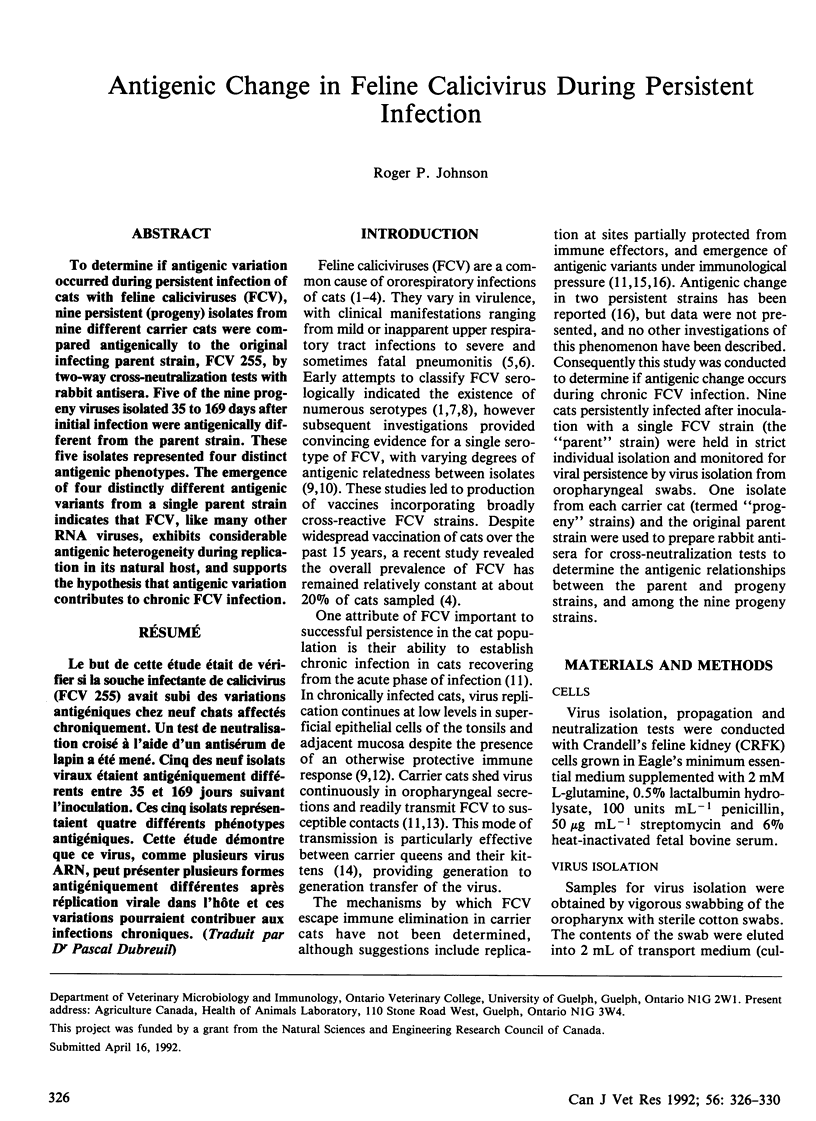
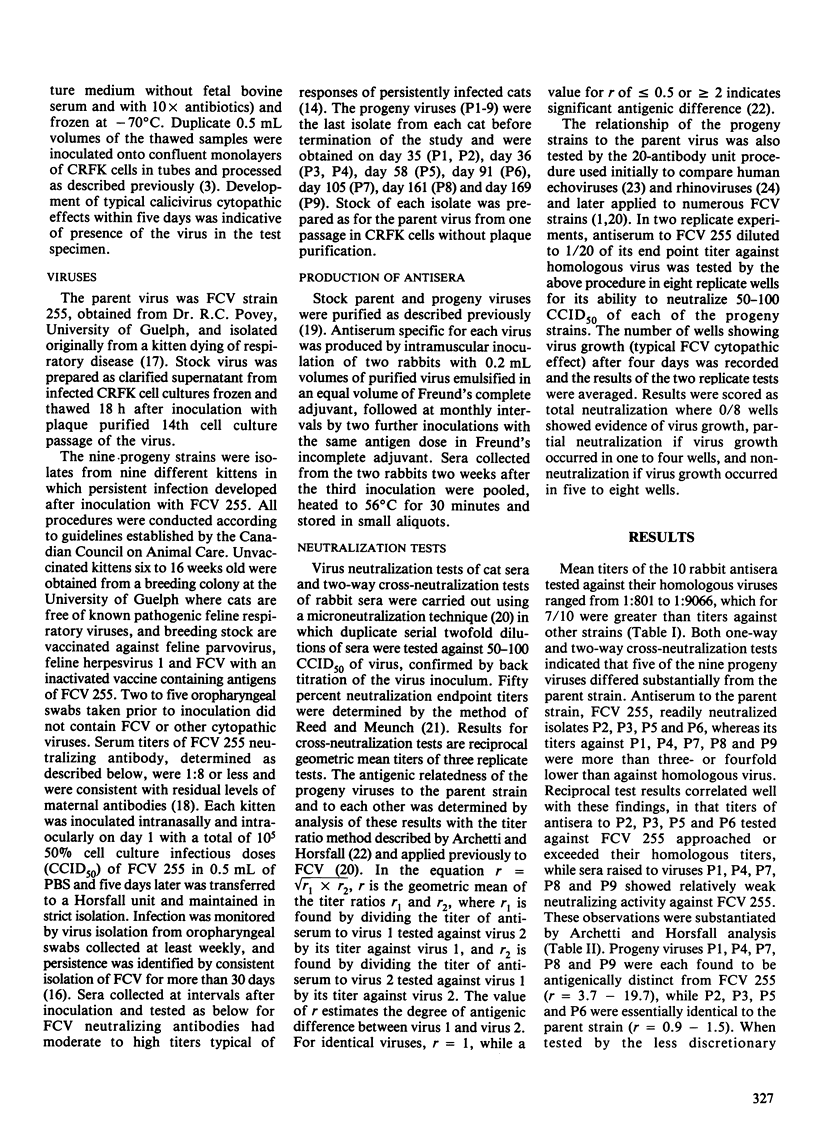
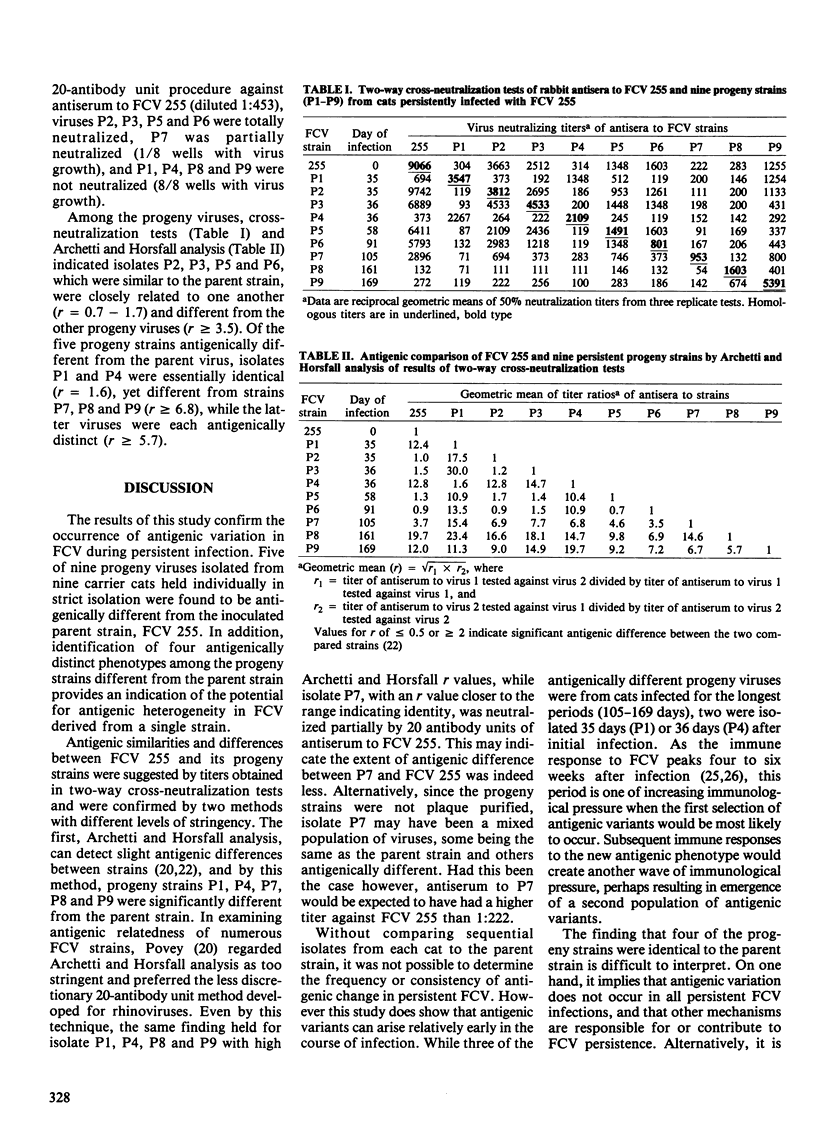
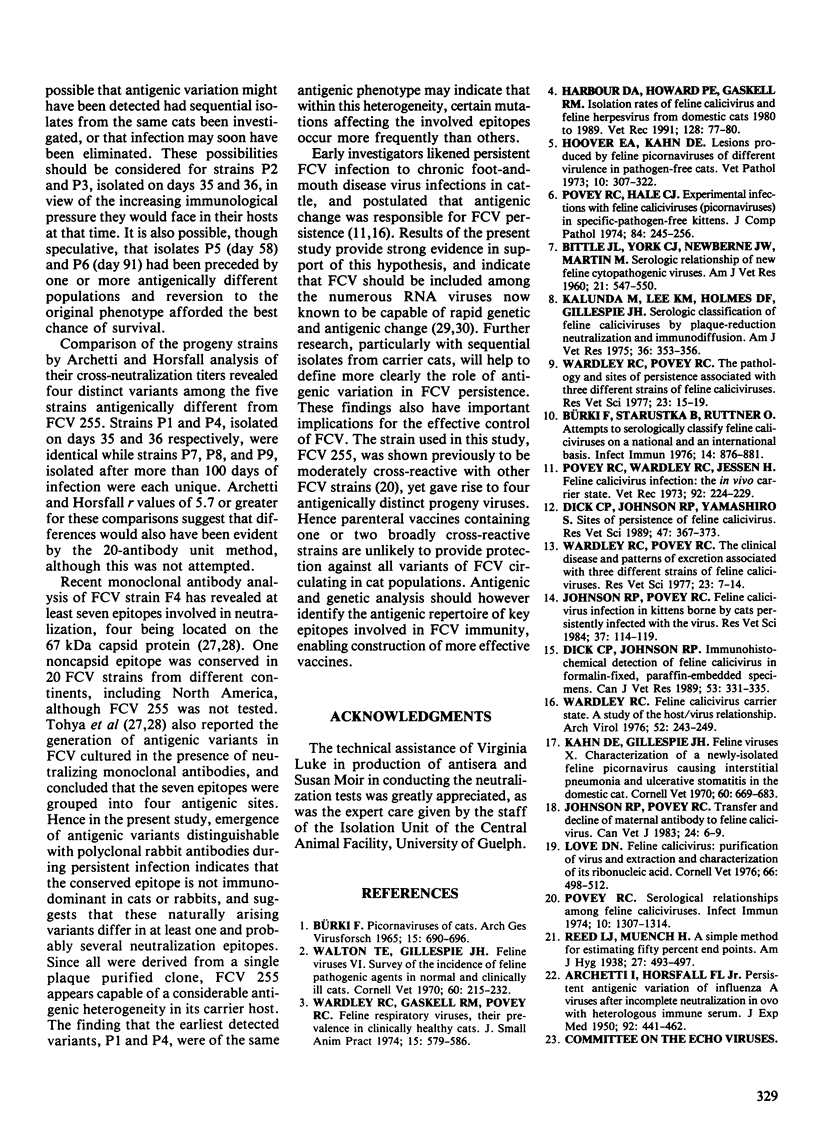
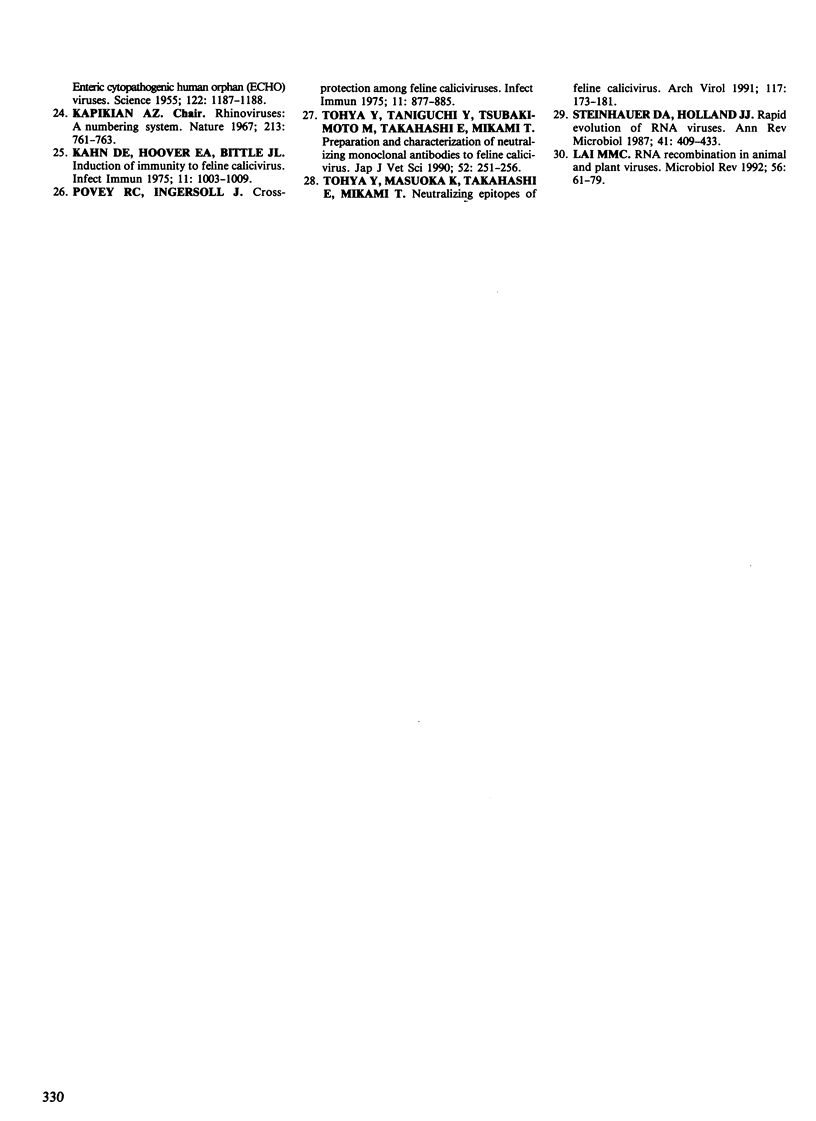
Selected References
These references are in PubMed. This may not be the complete list of references from this article.
- ARCHETTI I., HORSFALL F. L., Jr Persistent antigenic variation of influenza A viruses after incomplete neutralization in ovo with heterologous immune serum. J Exp Med. 1950 Nov 1;92(5):441–462. doi: 10.1084/jem.92.5.441. [DOI] [PMC free article] [PubMed] [Google Scholar]
- Burki F., Starustka B., Ruttner O. Attempts to serologically classify feline caliciviruses on a national and an international basis. Infect Immun. 1976 Oct;14(4):876–881. doi: 10.1128/iai.14.4.876-881.1976. [DOI] [PMC free article] [PubMed] [Google Scholar]
- Bürki F. Picornaviruses of cats. Arch Gesamte Virusforsch. 1965;15(5):690–696. doi: 10.1007/BF01245215. [DOI] [PubMed] [Google Scholar]
- Dick C. P., Johnson R. P. Immunohistochemical detection of feline calicivirus in formalin-fixed, paraffin-embedded specimens. Can J Vet Res. 1989 Jul;53(3):331–335. [PMC free article] [PubMed] [Google Scholar]
- Dick C. P., Johnson R. P., Yamashiro S. Sites of persistence of feline calicivirus. Res Vet Sci. 1989 Nov;47(3):367–373. [PubMed] [Google Scholar]
- ENTERIC cytopathogenic human orphan (ECHO) viruses. Science. 1955 Dec 16;122(3181):1187–1188. [PubMed] [Google Scholar]
- Harbour D. A., Howard P. E., Gaskell R. M. Isolation of feline calicivirus and feline herpesvirus from domestic cats 1980 to 1989. Vet Rec. 1991 Jan 26;128(4):77–80. doi: 10.1136/vr.128.4.77. [DOI] [PubMed] [Google Scholar]
- Hoover E. A., Kahn D. E. Lesions produced by feline picornaviruses of different virulence in pathogen-free cats. Vet Pathol. 1973;10(4):307–322. doi: 10.1177/030098587301000404. [DOI] [PubMed] [Google Scholar]
- Johnson R. P., Povey R. C. Feline calicivirus infection in kittens borne by cats persistently infected with the virus. Res Vet Sci. 1984 Jul;37(1):114–119. [PubMed] [Google Scholar]
- Johnson R. P., Povey R. C. Transfer and decline of maternal antibody to feline calicivirus. Can Vet J. 1983 Jan;24(1):6–9. [PMC free article] [PubMed] [Google Scholar]
- Kahn D. E., Gillespie J. H. Feline viruses. X. Characterization of a newly-isolated picornavirus causing interstitial pneumonia and ulcerative stomatitis in the domestic cat. Cornell Vet. 1970 Oct;60(4):669–683. [PubMed] [Google Scholar]
- Kahn D. E., Hoover E. A., Bittle J. L. Induction of immunity to feline caliciviral disease. Infect Immun. 1975 May;11(5):1003–1009. doi: 10.1128/iai.11.5.1003-1009.1975. [DOI] [PMC free article] [PubMed] [Google Scholar]
- Kalunda M., Lee K. M., Holmes D. F., Gillespie J. H. Serologic classification of feline caliciviruses by plaque-reduction neutralization and immunodiffusion. Am J Vet Res. 1975 Apr;36(4 PT1):353–356. [PubMed] [Google Scholar]
- Lai M. M. RNA recombination in animal and plant viruses. Microbiol Rev. 1992 Mar;56(1):61–79. doi: 10.1128/mr.56.1.61-79.1992. [DOI] [PMC free article] [PubMed] [Google Scholar]
- Love D. N. Feline calicivirus: purification of virus and extraction and characterisation of its ribonucleic acid. Cornell Vet. 1976 Oct;66(4):498–512. [PubMed] [Google Scholar]
- Povey C., Ingersoll J. Cross-protection among feline caliciviruses. Infect Immun. 1975 May;11(5):877–885. doi: 10.1128/iai.11.5.877-885.1975. [DOI] [PMC free article] [PubMed] [Google Scholar]
- Povey R. C., Hale C. J. Experimental infections with feline caliciviruses (picornaviruses) in specific-pathogen-free kittens. J Comp Pathol. 1974 Apr;84(2):245–256. doi: 10.1016/0021-9975(74)90065-6. [DOI] [PubMed] [Google Scholar]
- Povey R. C. Serological relationships among feline caliciviruses. Infect Immun. 1974 Dec;10(6):1307–1314. doi: 10.1128/iai.10.6.1307-1314.1974. [DOI] [PMC free article] [PubMed] [Google Scholar]
- Povey R. C., Wardley R. C., Jessen H. Feline picornavirus infection: the in vivo carrier state. Vet Rec. 1973 Mar 3;92(9):224–229. doi: 10.1136/vr.92.9.224. [DOI] [PubMed] [Google Scholar]
- Rhinoviruses: a numbering system. Nature. 1967 Feb 25;213(5078):761–762. doi: 10.1038/213761a0. [DOI] [PubMed] [Google Scholar]
- Steinhauer D. A., Holland J. J. Rapid evolution of RNA viruses. Annu Rev Microbiol. 1987;41:409–433. doi: 10.1146/annurev.mi.41.100187.002205. [DOI] [PubMed] [Google Scholar]
- Tohya Y., Masuoka K., Takahashi E., Mikami T. Neutralizing epitopes of feline calicivirus. Arch Virol. 1991;117(3-4):173–181. doi: 10.1007/BF01310763. [DOI] [PubMed] [Google Scholar]
- Tohya Y., Taniguchi Y., Tsubakimoto M., Takahashi E., Mikami T. Preparation and characterization of neutralizing monoclonal antibodies to feline calicivirus. Nihon Juigaku Zasshi. 1990 Apr;52(2):251–256. doi: 10.1292/jvms1939.52.251. [DOI] [PubMed] [Google Scholar]
- Walton T. E., Gillespie J. H. Feline viruses. VI. Survey of the incidence of feline pathogenic agents in normal and clinically-ill cats. Cornell Vet. 1970 Apr;60(2):215–232. [PubMed] [Google Scholar]
- Wardley R. C. Feline calicivirus carrier state. A study of the host/virus relationship. Arch Virol. 1976;52(3):243–249. doi: 10.1007/BF01348021. [DOI] [PubMed] [Google Scholar]
- Wardley R. C., Gaskell R. M., Povey R. C. Feline respiratory viruses--their prevalence in clinically healthy cats. J Small Anim Pract. 1974 Sep;15(9):579–586. doi: 10.1111/j.1748-5827.1974.tb06538.x. [DOI] [PubMed] [Google Scholar]
- Wardley R. C., Povey R. C. The clinical disease and patterns of excretion associated with three different strains of feline caliciviruses. Res Vet Sci. 1977 Jul;23(1):7–14. [PubMed] [Google Scholar]
- Wardley R. C., Povey R. C. The pathology and sites of persistence associated with three different strains of feline calicivirus. Res Vet Sci. 1977 Jul;23(1):15–19. [PubMed] [Google Scholar]


